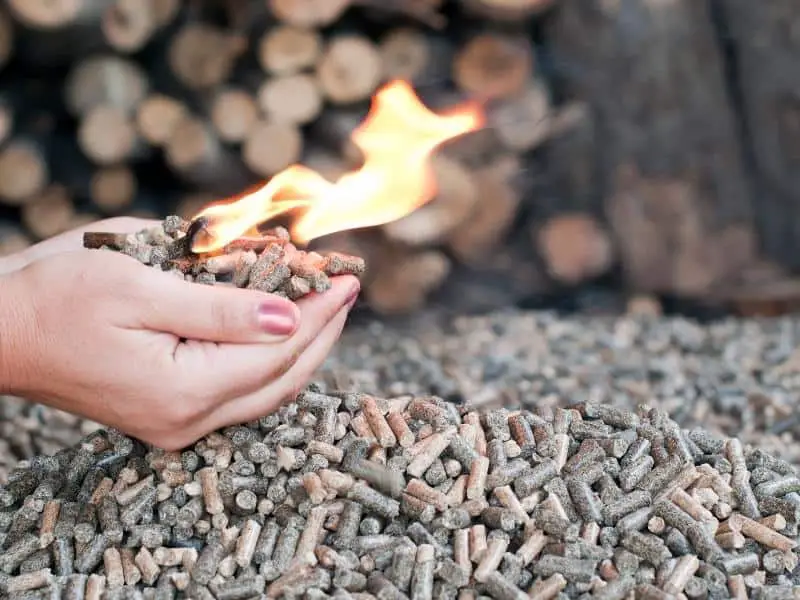The use of biogas as a clean fuel is definitely on the rise!
Biogas is a renewable, clean fuel and a free byproduct of the natural process of decay all dead lifeforms experience. It just has to be captured for use. Once that happens, we can convert it into free electricity, use it as free fuel, or sold for conversion into vehicle fuel.
In today’s article, we’ll be telling you why biogas makes an excellent fuel source, and why it is part of the future of green and free energy, as well as providing answers to questions people commonly have about this clean energy source that is already helping to power the future.
Here’s why biogas makes an excellent fuel.
Biogas naturally forms from decaying matter in an anaerobic environment, and it can be used as fuel immediately without processing. Its popularity is rising on farms, in particular, because it gives free fuel and makes a byproduct called digestate that helps the soil.
Biogas is not difficult to collect, and it burns cleanly, making it eco-friendly.

Why Choose Biogas as a Fuel?
Biogas makes an excellent fuel because it is effective, and it comes from nature, which means it is free. It also burns cleaner than fossil fuels, making it eco-friendly and safe for the environment.
Here are some of the key points we will go over today as well as some questions you may have:
- Why is biogas a good fuel, and how do we get it?
- How can we use biogas?
- Is biogas clean, safe, and effective?
Now that we’ve learned we can have free fuel, let’s see how to get it and use it.
Where Does Biogas Come From?
Biogas comes from the natural decomposition of organic (plants and animals) matter. Biogas comes from landfills, farms, swamps, lakes, ponds, and anywhere else that provides the right anaerobic conditions for bacteria to break down biomass and create biogas.
This natural process occurs almost everywhere in the world every minute of every day. Usually, these gases escape into the atmosphere, never to be used. However, if we let nature take its course, but collect the gas, we have a free and green fuel source.
Many waste products commonly thrown away can make biogas. On farms, animals make manure, grass grows, and harvested crops leave behind dead plants. Human waste goes into sewers. People at home and the food industry discard leftovers. Leaves fall from trees.
The amount of organic material available for harvest is almost unlimited, and the resulting fuel the process provides helps reduce dependence on fossil fuels.
What Does Anaerobic Mean?
Anaerobic means an environment without oxygen. So, in practical terms here on Earth, it means without air, which eliminates access to oxygen in the process. The easiest way to achieve this is to submerge organic material in water.
How Does Biogas Work?
Biogas works as a fuel because of the bacteria that live in an anaerobic environment. In an aerobic (oxygen-rich) environment, such as a compost pile, biogas does not form since a properly maintained compost pile gets turned over to let in air.
The right environment attracts certain bacteria, and they set to work on the process of anaerobic digestion. The waste product of the bacteria digestion consists of about 50-70% methane, a highly flammable gas. Mostly carbon dioxide makes up the remaining 30-40%.
The percentage of flammable methane present means you can harvest biogas and use it immediately. Biogas can become natural gas, but not in its raw form. The raw biogas has to be gasified in a treatment process to remove the CO2 and make biomethane.
What Uses Does Biogas Have?
Biogas makes such a good and promising fuel because it has many of the same uses as fossil fuels, and it is bioavailable and comes from the waste we already generate and do not use.
At present, biogas production is nowhere near the amount needed to replace gasoline, coal, and other fossil fuels, providing less than half of a percent of the fuel consumed in the United States.
Even if production ramps up, we will use biogas in conjunction with fossil fuels for many years to come. However, there is a huge reservoir of untapped potential in biogas if entrepreneurs and investors notice an opportunity, and the energy sector realizes the benefits.
What Immediate Uses Does Biogas Fuel Have?
One of the greatest benefits of biogas is that you can trap it, store it, and use it raw for immediate fuel. In raw form, biogas still burns cleanly because methane does not smoke or leave behind harmful pollutants that are bad for the environment and people.
If biogas has a tragic failing, it’s due to methane not easily compressing, and people usually use it onsite, rather than trying to transport it. But this is okay because it has many onsite uses and saves money in many ways when electricity or fuel is not purchased.
Immediate onsite uses include:
- Produce heat
- Produce electricity
- Use it in engines, microturbines, and fuel cells
- Cooking
What Uses Does Biogas Have After Treatment?
After treatment, called gasification, biogas can replace conventional natural gas. Biogas can become a renewable natural gas (RNG), also called biomethane, after a refining process to remove CO2 and other impurities, leaving only methane.
Once this process is complete, RNG becomes interchangeable with conventional natural gas, which means it is safe to inject into the existing natural gas grid, including pipelines.
This flexibility means RNG, on a national level, is suitable for electricity, industrial purposes, and cooking.
RNG can undergo a further process that allows it to fuel cars and other vehicles. Most commonly, the gas becomes compressed natural gas (CNG), which has a comparable fuel economy to conventional gasoline vehicles.
RNG can also undergo a laborious and expensive process to make liquefied natural gas (LNG). LNG not only costs more to produce but also to store, making it less common than CNG. LNG works better in heavy-duty vehicles that travel long distances.
What Are the Benefits of Using Biogas?
There is a wide range of benefits from using biogas, with more to be discovered:
- Lower energy bills
- The byproduct digestate improves fertilizer
- Less dependence on fossil fuels, foreign and domestic, boosts the economy
- Less environmental pollution
- Less chance of toxicity or pathogen transmission than untreated waste
- Another source of jobs helps the economy
- More stable and easily controlled
- No dark carbon residue forms on pots or other surfaces after burning
- Renewable and quicker than getting natural gas
- Smoke-free and odorless burn
How is Biogas Eco-Friendly?
Biogas burns cleanly and keeps the environment cleaner because the bacteria do not release methane directly into the atmosphere during decay.
When raw biogas burns, methane burns cleanly without residue, and CO2, water, and some trace gases release into the air, a much better solution than decomposition sending methane gas into the atmosphere unchecked.
Furthermore, creating biogas recycles some minerals and nutrients in the decaying material. When we fortify soil or fertilizer with the leftover digestate, we use fewer petrochemicals and mined fertilizers.
How Does Biogas Help With Waste Management?
Collecting or flaring (burning) biogas from a landfill keeps harmful methane away from the atmosphere compared to open-air trash dump sites.
Open-air trash dumps are dangerous contributors to methane release into the atmosphere and might spread diseases or pollute the environment.
Modern landfills bury all the trash underground and have a pipe that allows the biogas to escape. Dumping everything underground creates an anaerobic condition without submerging the contents underwater to remove the air.
Some landfills that create biogas this way flare the gas off. They exist only to keep methane out of the atmosphere and away from people for eco-friendly and safety purposes.
Furthermore, harmful and toxic biowaste, such as food leftovers, safely breaks down and does not contaminate drinking water or hurt the environment in other ways. Also, the process handles flammable methane safely to improve public safety.
This gas is not the same as biogas initially due to the nature of collecting it from trash, so we call it landfill gas. Landfill gas gets treated to remove CO2, water vapor, and hydrogen sulfide, which is harmful and toxic in high enough concentrations.
Landfill gas becomes a natural gas after treatment, and landfills can use it to create power for themselves or sell it for use just like conventional natural gas.
How Do Farms Use Biogas?
The chief way farms use biogas is to cut costs by using the fuel for power or heat.
Some farmers buy special containers called anaerobic digesters that store biowaste for biogas production. Others store animal manure in holding ponds with a specially designed cover to collect biogas.
Whichever methods they use, farmers can then use biogas as fuel or sell it to supplement their income. For example, they run an electric generator and lower or eliminate their electricity bill.
Sources




